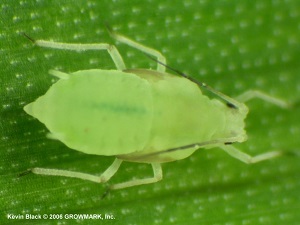Key Points:
- Mild winter conditions can lead to early spring aphid problems in wheat.
- Aphids are known to transmit barley yellow dwarf virus (BYDV).
- Aphid distribution in wheat is patchy. Scout several locations per field.
- Thresholds vary by state and by species, but as few as 12-15 bird cherry aphids per linear foot of row may justify spring insecticide applications.
Mild winter weather can lead to early spring problems with aphids in winter wheat. Several species may infest winter wheat, with the most common types being bird cherry oat aphids, greenbug aphids, English grain aphids, and corn leaf aphids. Most of our spring aphid infestations come from southern migrants, but the bird cherry oat aphid can overwinter locally in a mild year and may even feed throughout the winter. This species is also the one we tend to encounter first in the season under normal winter conditions.
Aphids cause two types of damage: direct injury by sap feeding, and indirect injury through transmission of barley yellow dwarf virus (BYDV). Sap feeding is more injurious during head filling. Most BYDV infection occurs as a result of fall aphid feeding activity on seedling wheat the first 30 days after emergence. Greenbug and bird cherry oat aphids are known to transmit BYDV, especially when mild weather conditions persist into late fall after planting. Systemic insecticide seed treatments can effectively reduce aphid activity and subsequent BYDV infection. Spring aphid activity is seldom severe enough to justify insecticide application, either for direct feeding damage from the aphids, or for transmission of BYDV.
Wheat should be actively scouted in the early spring when temperatures routinely exceed 45 degrees F, especially when winter weather has been mild. Aphids exhibit aggregate (or patchy) distribution, so several areas of the field should be scouted to get an accurate assessment. Thresholds are debated scientifically and vary both by state and by species. One credible university source suggests a threshold of 10 aphids per linear foot of row in wheat that is more than 60 days after emergence. Thresholds during the grain fill period are 50-100 aphids per head. Scouting should consider beneficial insect populations, stage and condition of wheat, and any additional stressors like dry weather.
Factors that will increase likelihood of positive economic return on an insecticide application would be intensive wheat management systems, high yield potential, late and warm fall, mild winter or snow cover, early warm spring, aphids present above threshold, and variety susceptible to BYDV. The active ingredients of common foliar insecticides labeled for aphid control in wheat include lambda-cyhalothrin, zeta-cypermethrin, and cyfluthrin. ALWAYS read and follow pesticide label directions and make sure products are labeled for your geography.
Contact your FS Crop Specialist for your agronomic information.

